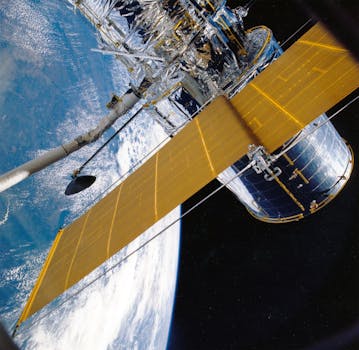GEO Satellites: Introduction to Geostationary Orbit Satellites
GEO satellites, or geostationary orbit satellites, are a type of satellite that orbits the Earth at an altitude of approximately 36,000 kilometers, remaining stationary relative to a fixed point on the planet. This unique characteristic allows GEO satellites to provide continuous coverage of a specific region, making them ideal for various applications such as telecommunications, navigation, and weather forecasting. The Focus Keyword: GEO satellites is a crucial aspect of modern space technology, and understanding its significance is essential for appreciating the role of these satellites in our daily lives.
The concept of GEO satellites was first proposed by scientist Arthur C. Clarke in 1945, and the first geostationary satellite, Syncom 2, was launched in 1963. Since then, numerous GEO satellites have been launched, with many more planned for the future. These satellites have revolutionized the way we communicate, navigate, and monitor the environment, and their impact will only continue to grow as technology advances.
GEO Satellites: Technology and Applications
GEO satellites use a combination of solar panels and batteries to generate power, which is then used to operate their onboard systems and transmit signals back to Earth. The satellites are typically equipped with transponders, which receive and retransmit signals, allowing for communication between different locations on the planet. The technology behind GEO satellites is complex, involving advanced materials, propulsion systems, and communication equipment.
The applications of GEO satellites are diverse and widespread. In telecommunications, they provide internet connectivity, voice and data services, and broadcast television programming to remote and underserved areas. In navigation, GEO satellites are used for precision timing and location services, such as GPS and GLONASS. Weather forecasting also relies heavily on GEO satellites, which provide high-resolution images of cloud patterns, sea surface temperatures, and other environmental factors.
GEO Satellites: Benefits and Challenges
The benefits of GEO satellites are numerous. They provide global coverage, enabling communication and navigation services to reach even the most remote areas. They also offer high-gain antennas, which allow for stronger signal transmission and reception. Additionally, GEO satellites have a long lifespan, typically ranging from 10 to 15 years, making them a cost-effective solution for many applications.
However, GEO satellites also face several challenges. One of the primary concerns is orbital congestion, as the increasing number of satellites in geostationary orbit poses a risk of collisions and interference. Another challenge is the limited availability of spectrum, which can limit the capacity and quality of services provided by GEO satellites. Furthermore, the high cost of launching and maintaining GEO satellites can be a significant barrier to entry for new players in the industry.
GEO Satellites: Future Developments and Advancements
Despite the challenges, the future of GEO satellites looks promising. Advances in technology are enabling the development of more efficient and capable satellites, such as high-throughput satellites (HTS) and very high-throughput satellites (VHTS). These next-generation satellites will provide faster data rates, greater connectivity, and more services, further expanding the reach and capabilities of GEO satellites.
Additionally, the growing demand for satellite-based services, such as satellite broadband and 5G connectivity, is driving innovation and investment in the GEO satellite sector. New launch vehicles and satellite manufacturing techniques are being developed, which will reduce costs and increase access to space. As the industry continues to evolve, we can expect to see even more exciting developments and applications of GEO satellites in the years to come.
